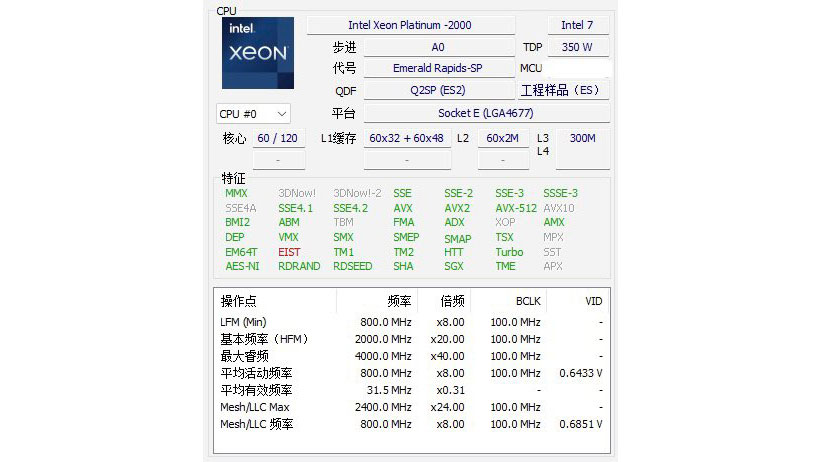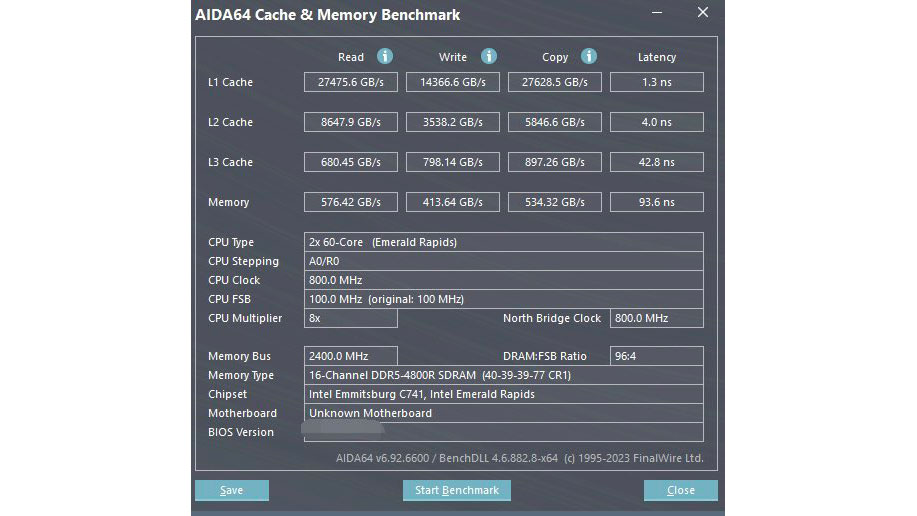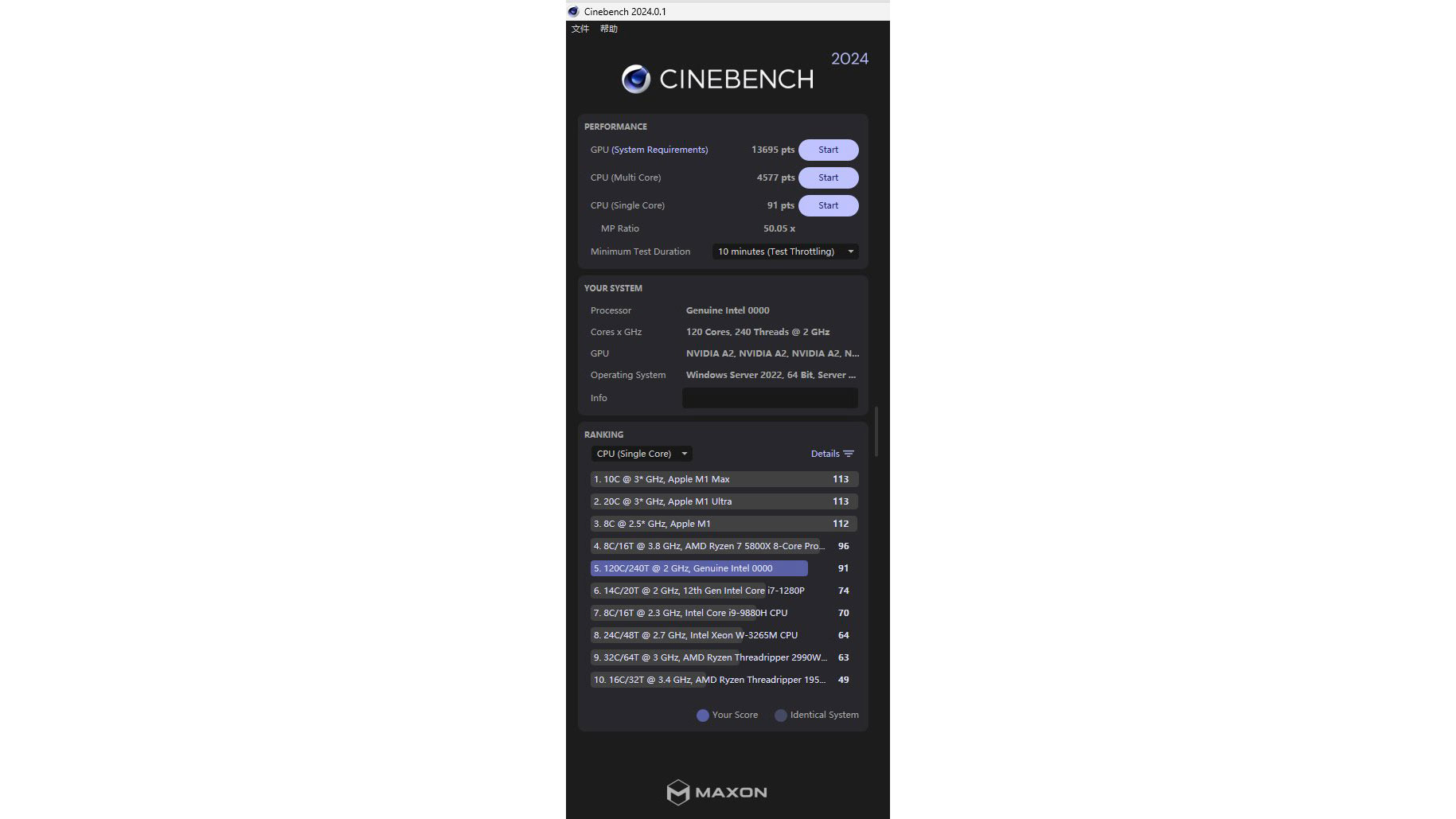5th-Gen Emerald Rapids CPU Leak Shows 60 Cores, 420MB Cache

Intel's 5th-generation Xeon (Emerald Rapids) processors are slated to hit the market on December 14. However, the Xeon Platinum 8580, likely the successor to the existing Xeon Platinum 8480+ (Sapphire Rapids), has already leaked. The chip is currently in its ES2 (engineering sample 2) state, so the final specifications will likely vary.
As a quick refresher, Emerald Rapids will replace Sapphire Rapids, and the upcoming 10nm server chips will compete with AMD's 5th-generation EPYC Turin lineup that should launch before 2024 concludes. Emerald Rapids still uses the Intel 7 (formerly 10nm Enhanced SuperFin) process node. Emerald Rapids will wield the newer Raptor Cove cores, unlike Sapphire Rapids, which taps Intel's Golden Cove cores. In a certain sense, Emerald Rapids is to Sapphire Rapids like Raptor Lake was to Alder Lake.
Emerald Rapids has its work cut out for it. EPYC Turin will be (in all likelihood) based on 4nm and 3nm nodes from TSMC. Regarding manufacturing processes, EPYC Turin is leagues above Emerald Rapids, which is stuck on Intel 7. EPYC Turin will also wield AMD's new Zen 5 cores, expected to bring significant performance uplifts over Zen 4. AMD will launch EPYC Turin into three categories: the regular Zen 5, Zen 5 with 3D V-Cache, and Zen 5c. Therefore, EPYC Turin will compete on all levels against Emerald Rapids.
Intel Xeon Platinum 8580 Specifications
| Processor | Cores / Threads | Base Clock (MHz) | L2 Cache (MB) | L3 Cache (MB) | TDP (W) |
|---|---|---|---|---|---|
| EPYC 9654 | 96 / 192 | 2,400 | 96 | 384 | 360 |
| EPYC 9554 | 64 / 128 | 3,100 | 64 | 256 | 360 |
| Xeon Platinum 8580* | 60 / 120 | 2,000 | 120 | 300 | 350 |
| Xeon Platinum 8490H | 60 / 120 | 1,900 | 120 | 112.5 | 350 |
| Xeon Platinum 8480+ | 56 / 112 | 2,000 | 112 | 105 | 350 |
*Specifications are unconfirmed.
The Xeon Platinum 8580 (ES2-Q2SP-A0), courtesy of hardware leaker YuuKi_AnS, surfaces with a 2,000 MHz base clock. It's ES silicon, so don't pay clocks any attention for now. The Emerald Rapids chip seemingly sports a 60-core, 120-thread design. The processor ties the Xeon Platinum 8490H in terms of core count, but comes with four extra cores than the Xeon Platinum 8480+ that it's replacing.
In other words, Intel is still trying to play catch-up with AMD in terms of cores. With the current 4th-generation EPYC 9004 (Genoa) series, AMD has pushed the total number of cores to 96 with the EPYC 9654. Therefore, there's still a substantial difference of 60% between Intel and AMD's highest-core server chips.
After getting cold feet on the whole chiplet idea, Intel ultimately made Emerald Rapids with two large dies, taking a 180-degree detour from Sapphire Rapids' design with four small dies. Each Sapphire Rapid die houses 15 cores for a maximum of 60 cores. Emerald Rapids features 33 cores per die, totaling up to 66. But it's uncertain if Intel will produce a maxed-out Emerald Rapids SKU.
The radical shift in design allowed Intel to slap more L3 cache on Emerald Rapids. The L2 cache has not changed. There's still 2MB of L2 cache per core, which is why the Xeon Platinum 8580 has the same amount of L2 cache as the Xeon Platinum 8490H, since both are 60-core chips. The Xeon processors possess 25% more L2 cache than the EPYC 9654.
Get Tom's Hardware's best news and in-depth reviews, straight to your inbox.




The L3 cache, however, is one of Emerald Rapids' most significant assets. Sapphire Rapids had 1.875MB of L3 cache per core. Intel bumped that up to 5MB per core on Emerald Rapids, a 2.66X improvement over Sapphire Rapids. As a result, 60-core models (like the Xeon Platinum 8580) have up to 300MB of L3 cache compared to the Xeon Platinum 8490H's 112.5MB L3 cache.
But AMD doesn't have a 60-core Genoa SKU. Therefore, the 64-core EPYC 9554 is the closest comparison. The Xeon Platinum 8580 offers 87.5% and 17.2% higher L2 and L3 cache than the EPYC 9554, respectively. Genoa still has the most L3 cache on a processor that doesn't have a 3D V-Cache or HBM. The EPYC 9654, which is the top Genoa model, has 28% more L3 cache compared to the Xeon Platinum 8580.
Emerald Rapids will drop right into Intel's existing Eagle Stream platform with the LGA4677 socket, thus retaining eight-channel memory support. However, Emerald Rapids natively supports DDR5-5600 as opposed to Sapphire Rapids' DDR5-4800. The improved memory support will help boost the memory bandwidth available to the cores. Like Sapphire Rapids, Emerald Rapids continues to offer consumers 80 high-speed PCIe 5.0 lanes for connectivity.
We're only a few months away from the Emerald Rapids and EPYC Turin launches. It'll be a glorious battle among the two behemoths to see which server chip prevails.

Zhiye Liu is a news editor, memory reviewer, and SSD tester at Tom’s Hardware. Although he loves everything that’s hardware, he has a soft spot for CPUs, GPUs, and RAM.
-
thestryker Depending on where Intel takes the additional cache we could end up with a twisted circumstance of an overclocked Xeon W being the fastest gaming chip on the market. Leaked SKUs show down to 48c with 300MB L3 so if they can carry that cache/core ratio down we could hypothetically see a 16c workstation chip with 100MB L3. Unless EMR overclocks worse than SPR this could easily be the fastest gaming CPU so long as you were willing to toss efficiency out the window.Reply
It's still not something I'd personally do because the platform costs are way too high for me (even though it'd be the perfect replacement for my system), but I'd certainly find it funny. -
bit_user Reply
We saw that example of someone clocking 56-core SPR to 5.5 GHz (all-core) on 1.9 kW. Cooled using liquid nitrogen, which means each run typically destroys both the CPU and motherboard. I wonder how much power it would take to clock the small die W-2400 series that high (coincidentally featuring up to 24 cores), and how high you could clock them on chilled water.thestryker said:Depending on where Intel takes the additional cache we could end up with a twisted circumstance of an overclocked Xeon W being the fastest gaming chip on the market. Leaked SKUs show down to 48c with 300MB L3 so if they can carry that cache/core ratio down we could hypothetically see a 16c workstation chip with 100MB L3. Unless EMR overclocks worse than SPR this could easily be the fastest gaming CPU so long as you were willing to toss efficiency out the window.
It's still not something I'd personally do because the platform costs are way too high for me (even though it'd be the perfect replacement for my system), but I'd certainly find it funny.
https://www.tomshardware.com/news/intel-xeon-w9-3495x-can-draw-1900w
It's not only the size of L3 that matters. Here's what Chips & Cheese found. Pay attention to the L3 section.
"Intel’s decision to trade latency for capacity is likely driven by their focus on high vector performance, as well as an emphasis on high L3 capacity over L3 performance. Sapphire Rapids suffers from an extremely high L3 latency around 33 ns. L3 latency also regressed by about 33% compared to Ice Lake SP. I think this regression is because Intel’s trying to solve a lot of engineering challenges in SPR."
Source: https://chipsandcheese.com/2023/03/12/a-peek-at-sapphire-rapids/
One thing to note is that they're using 2 MiB pages. I think that's probably not a good move for gaming systems, leaving me to wonder what kind of difference it makes.
Another thing I wonder is how it would look on the W-2400, which has a monolithic die, since your L3 lookups wouldn't have to traverse the die interconnects or search as many L3 slices. I also wonder what Intel will do, regarding the small die Xeon W-2500. Will it have just one of those two big tiles that we see in the 60-core models? -
thestryker Reply
That's exactly what I was thinking: if the high L3 capacity goes down to the MCC die it could lead to some really interesting performance numbers.bit_user said:Another thing I wonder is how it would look on the W-2400, which has a monolithic die, since your L3 lookups wouldn't have to traverse the die interconnects or search as many L3 slices. I also wonder what Intel will do, regarding the small die Xeon W-2500. Will it have just one of those two big tiles that we see in the 60-core models?
I was kinda disappointed that nobody seemed to get any of the W-2400 overclockable chips in, because I thought they'd be really interesting to see. -
bit_user Reply
Here's one example of W7-2495X overclocking:thestryker said:I was kinda disappointed that nobody seemed to get any of the W-2400 overclockable chips in, because I thought they'd be really interesting to see.
https://skatterbencher.com/2023/03/29/skatterbencher-59-intel-xeon-w7-2495x-overclocked-to-5200-mhz/
I think 5.2 GHz is just the fastest he got any cores to run. I only skimmed it, but the claimed, peak all-core frequency of 4.9 GHz was achieved with AVX either downclocked or disabled. That wouldn't give me confidence to recommend Emerald Rapids as the top gaming machine. -
Demon of Elru I was hoping this could replace my X299 system but we'll see. Its a really expensive platform for a non gaming purpose. Though it would do gaming just fine I imagine. Glad I held out getting Sapphire Rapids.Reply -
thestryker Reply
That's a lot lower than I was expecting, but it is the 24c and they were maximizing overall clocks. When you're pulling 600W+ there's only so much you're going to get. I'd be curious how high you could get 8c while dumping the clocks on the rest.bit_user said:Here's one example of W7-2495X overclocking:
https://skatterbencher.com/2023/03/29/skatterbencher-59-intel-xeon-w7-2495x-overclocked-to-5200-mhz/
I think 5.2 GHz is just the fastest he got any cores to run. I only skimmed it, but the claimed, peak all-core frequency of 4.9 GHz was achieved with AVX either downclocked or disabled. That wouldn't give me confidence to recommend Emerald Rapids as the top gaming machine. -
bit_user Reply
Yeah, I did have the thought that perhaps you could squeeze out a couple hundred more MHz, if on a 16c model, like you mentioned. Given the highest they got 2 cores was 5.2 GHz, I think we can safely say dropping to 16 or even 8 cores won't net you too much.thestryker said:That's a lot lower than I was expecting, but it is the 24c and they were maximizing overall clocks. When you're pulling 600W+ there's only so much you're going to get. I'd be curious how high you could get 8c while dumping the clocks on the rest.
BTW, remember that the version of Golden Cove in Sapphire Rapids is different than the one in Alder Lake. They bolted on an additional AVX-512 FMA unit (labelled FMA EUs on Port 5, below), AMX, the mesh agent, and more L2 cache. It's quite likely that these additions weren't designed to make the same timing targets as the desktop CPUs, because power constraints would make such clockspeeds impractical for large core counts and designing to more lax timing enables more work per pipeline stage per cycle.
Source: https://locuza.substack.com/p/die-walkthrough-alder-lake-sp-and -
thestryker Reply
Yeah I could see that, and I'm sure there are likely refinements that had been made for RPL which aren't in SPR which will make their way into EMR. They actually had 6 cores with a 52x multiplier and the boost was set to allow up to 8 to get that high.bit_user said:Yeah, I did have the thought that perhaps you could squeeze out a couple hundred more MHz, if on a 16c model, like you mentioned. Given the highest they got 2 cores was 5.2 GHz, I think we can safely say dropping to 16 or even 8 cores won't net you too much.
BTW, remember that the version of Golden Cove in Sapphire Rapids is different than the one in Alder Lake. They bolted on an additional AVX-512 FMA unit (labelled FMA EUs on Port 5, below), AMX, the mesh agent, and more L2 cache. It's quite likely that these additions weren't designed to make the same timing targets as the desktop CPUs, because power constraints would make such clockspeeds impractical for large core counts and designing to more lax timing enables more work per pipeline stage per cycle.
Source: https://locuza.substack.com/p/die-walkthrough-alder-lake-sp-and
I will say one thing that has really surprised me with SPR is that the memory controller seems really good as everyone who's tested one with 6800 seems to just get it to work which certainly wasn't the case for ADL.